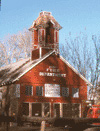February 13, 2015
Ridgway Walking Tour
 Ridgway is an historic district composed of a variety of railroad era buildings and homes, some rough-hewn log cabins, others elegant brick and frame structures. It is a 1890s town in the valley, western in character, named in honor of a railroad superintendent, Robert M. Ridgway. The town sprang to life, thrived in its early years, then declined. Ridgway is described by author/historian, Doris Gregory in “The Town That Refused to Die.” Described as a town that struggled to live for almost one-hundred years, it’s managed to suvive, and is still surviving, even in this downturn economy. The town’s diehard spirit keeps it going even in the toughest of times. Ridgway still sports buildings featured in the John Wayne movie, “True Grit,” as well as others worthy of mention when touring the town.
Ridgway is an historic district composed of a variety of railroad era buildings and homes, some rough-hewn log cabins, others elegant brick and frame structures. It is a 1890s town in the valley, western in character, named in honor of a railroad superintendent, Robert M. Ridgway. The town sprang to life, thrived in its early years, then declined. Ridgway is described by author/historian, Doris Gregory in “The Town That Refused to Die.” Described as a town that struggled to live for almost one-hundred years, it’s managed to suvive, and is still surviving, even in this downturn economy. The town’s diehard spirit keeps it going even in the toughest of times. Ridgway still sports buildings featured in the John Wayne movie, “True Grit,” as well as others worthy of mention when touring the town.
 The Herran House building, at 146 North Cora, is a good place to start your tour. It was built by farmer, painter and hotel keeper, Thomas Herran, in 1891. The building was first a hotel, later a boardinghouse, a physician-run clinic, and home to various commercial enterprises over the years. The building has always been called the “Herran House.” An old painted sign on the side of the building attests to that fact.
The Herran House building, at 146 North Cora, is a good place to start your tour. It was built by farmer, painter and hotel keeper, Thomas Herran, in 1891. The building was first a hotel, later a boardinghouse, a physician-run clinic, and home to various commercial enterprises over the years. The building has always been called the “Herran House.” An old painted sign on the side of the building attests to that fact.
 Across the street, on the corner of North Cora and Clinton is the Sherbino Building. Gus Kullerstrand, a premier Ouray builder, erected this structure for mining promoter and capitalist, Louis Sherbino in 1915. The corner building was first a drug store, later a post office and is now a cafe. The section of the building facing Clinton Street was the theater which opened September 17, 1915 with a silent movie and dance attended by about 200 people from the town and surrounding areas. At one time there was even bowling inside the building! The restored Sherbino Theater lives today, hosting plays, dances, and many social events.
Across the street, on the corner of North Cora and Clinton is the Sherbino Building. Gus Kullerstrand, a premier Ouray builder, erected this structure for mining promoter and capitalist, Louis Sherbino in 1915. The corner building was first a drug store, later a post office and is now a cafe. The section of the building facing Clinton Street was the theater which opened September 17, 1915 with a silent movie and dance attended by about 200 people from the town and surrounding areas. At one time there was even bowling inside the building! The restored Sherbino Theater lives today, hosting plays, dances, and many social events.
 Ridgway pioneer and respected businessman, Amos Walther built the Ridgway Bank Building on Clinton Street in 1911 to make a permanent home for the flourishing bank he had just purchased. The building was constructed of red brick with white sandstone trim. In 1931 the business closed after stock market losses in the great depression. Today an antique, arts, and book store is located here.
Ridgway pioneer and respected businessman, Amos Walther built the Ridgway Bank Building on Clinton Street in 1911 to make a permanent home for the flourishing bank he had just purchased. The building was constructed of red brick with white sandstone trim. In 1931 the business closed after stock market losses in the great depression. Today an antique, arts, and book store is located here.
Further west, at 755 Clinton Street, is the Walther residence. Amos Walther built this beautiful two-story, seven room frame home for his bride, Louise Augusta Corbett, of Ouray, in 1891. Here they raised a family and entertained friends until Louise’s death. Amos continued to live here until his death in 1955 at the age of ninety.
 The Hyde family were original homesteaders in the valley. Arthur Hyde built one of the first homes in town, at 509 Moffat, on the corner of Moffat and Lena streets. The abstract, dated 1892, bears the signature of Otto Mears. The home, and the land (on which Solar Ranches stands today) was later sold to the Hartwells, then the Criswells. Both families had large holdings in the town. Unfortunately, some enterprising soul tore this down to build an ugly commercial building.
The Hyde family were original homesteaders in the valley. Arthur Hyde built one of the first homes in town, at 509 Moffat, on the corner of Moffat and Lena streets. The abstract, dated 1892, bears the signature of Otto Mears. The home, and the land (on which Solar Ranches stands today) was later sold to the Hartwells, then the Criswells. Both families had large holdings in the town. Unfortunately, some enterprising soul tore this down to build an ugly commercial building.
While only a few places of distinction are shown here, continue walking about the town to enjoy other interesting buildings and conversation with friendly folk. Some of the sites you won’t want to miss are the old railroad station, now a private home, in the 300 block of West Sherman, across from the park in the center of town; the Hockley Hardware building, featured in True Grit as the “Fort Smith Saloon” the old Ridgway Fire Station, originally a high school (and now a sculptor’s home and studio) at the corner of North Lena and Clinton; and the little Leopard Creek School (transplanted from the Dallas Divide near the town of Sams) that is tucked into the alley at Hyde Street between South Cora and South Laura.
Story by Ann Hoffman. Photography by James Burke, Kathryn R. Burke
Site and Page content: Copyright San Juan Publishing Group, Inc. All rights reserved.
